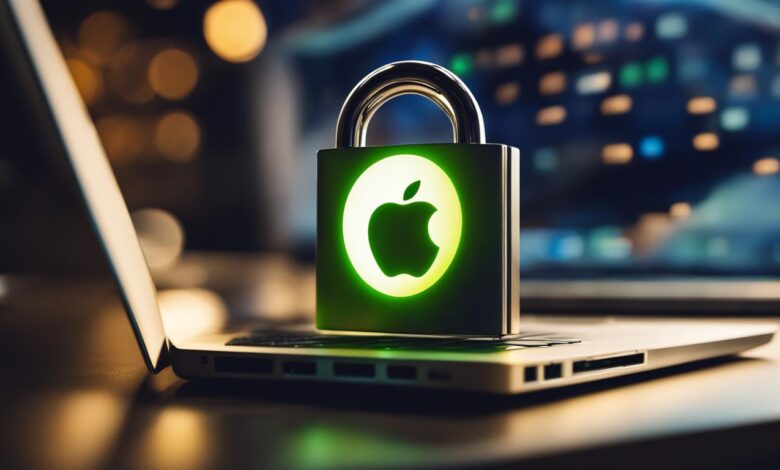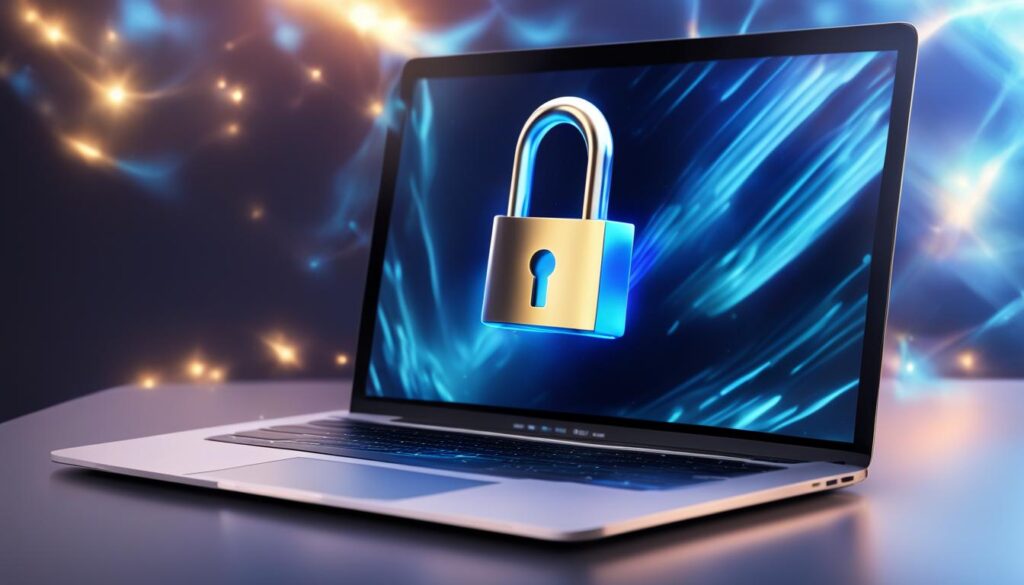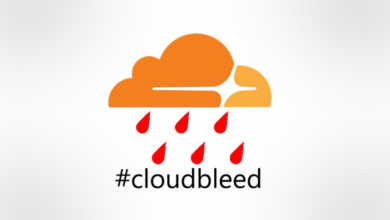Enhancing Macbook Security: Best Practices

As our lives become increasingly digital, it’s more important than ever to safeguard your Macbook against potential threats. Whether you use your device for personal or professional purposes, taking steps to maximize your digital safety is crucial. In this article, we’ll outline the best practices for enhancing the security of your Macbook, specifically in the United States.
From understanding the available security features to implementing secure browsing practices, we’ll walk you through everything you need to know to protect your Macbook. By following the tips outlined in this article, you can rest assured that your digital information is safe and secure.
Key Takeaways:
- Protecting your Macbook is essential to ensuring your digital safety in the US.
- Understanding available security features and implementing secure browsing habits can help enhance Macbook security.
- Configuring security settings and choosing the right antivirus software are also crucial steps in safeguarding your device.
- By following these best practices, you can protect your personal and professional information on your Macbook.
Understanding Macbook Security Features
If you are a Macbook user, you may already know that Macs are designed with built-in security features. The main purpose of these features is to protect your device and data from potential threats. Understanding each feature will enable you to leverage them to enhance security.
One such security feature is the Gatekeeper. This feature enables users to choose which apps to download and install from the internet. This way, you can ensure that only trusted applications are installed on your device.
The Firewall is another essential security feature for Macbooks. This feature acts as a barrier between your device and other devices on the network. The Firewall monitors incoming and outgoing internet connections and prohibits unauthorized access to your device.
Secure Browsing
Browsing the internet can expose your Macbook to various online threats such as phishing scams and malware. To ensure secure browsing, Safari has built-in security features such as Fraudulent Website Warning and Safe Browsing that are designed to protect users from malicious websites.

Another way to enhance secure browsing is by using Virtual Private Networks (VPNs), which are easily available for Macbooks. VPNs work by encrypting your internet connection, making it difficult for hackers or cybercriminals to intercept your online activities.
Tip: Ensure that your VPN is up to date and trustworthy, as some VPNs can actually compromise your security.
By understanding Macbook security features and implementing secure browsing practices, you can ensure your device is protected from potential online threats.
Configuring Security Settings
Configuring your Macbook’s security settings is crucial to ensuring optimal protection against potential security threats. By setting up your firewall and other security configurations properly, you can significantly reduce the risk of malicious attacks on your device.
Firewall Configuration
One of the most critical security settings on your Macbook is the firewall. A firewall is designed to block unauthorized access to your device while still allowing authorized traffic through.
To configure your firewall, follow these steps:
- Go to System Preferences and click Security & Privacy
- Select the Firewall tab
- Click the lock icon and enter your password to unlock the settings
- Turn on the Firewall
- Choose to block all incoming connections or allow only essential services and applications
It is recommended to choose the “Block all incoming connections” option unless you have a specific reason to allow incoming connections.
Other Security Configurations
Along with configuring your firewall, there are additional security settings you can adjust to enhance your Macbook’s security. These include:
- Enabling FileVault to encrypt your hard drive
- Disabling automatic login
- Enabling automatic updates for your operating system and applications
- Using a strong password for your user account
By taking these additional steps, you can further safeguard your Macbook against potential security threats.

Choosing Antivirus Software for Mac
Antivirus software is essential in protecting your Mac from malware, viruses, and other security threats. Macs may have a lower vulnerability rate compared to other operating systems, but it’s always better to be safe than sorry.
When choosing an antivirus software for your Mac, there are a few things to consider:
- Compatibility: Make sure the antivirus software is compatible with your Mac’s operating system.
- Features: Look for software that provides real-time protection, scanning, and removal of threats. Some antivirus software also includes additional features such as firewalls, parental controls, and password management.
- Price: Antivirus software can range from free to several hundred dollars. Consider your budget and the level of protection you need.
Here are some popular antivirus software options for Mac:
- Bitdefender Antivirus for Mac: This software offers real-time protection, automatic scans, and removal of threats, and includes a VPN and ad blocker. It costs $29.99 per year.
- Norton 360 Standard for Mac: This software provides real-time protection, automatic scans, and includes a firewall and parental controls. It costs $49.99 per year.
- Malwarebytes for Mac: This software offers real-time protection, scans and removes threats, and includes a free version. The premium version costs $39.99 per year.
Remember, antivirus software is just one aspect of keeping your Mac secure. Be sure to follow the best practices outlined in this article and practice secure browsing habits to maximize your digital safety.
Implementing Secure Browsing Practices
Ensuring secure browsing practices is essential for safeguarding your Macbook from potential security threats. Here are few best practices to consider:
- Use a VPN: A Virtual Private Network (VPN) encrypts your internet traffic and protects your online privacy. It creates a secure connection to the internet, preventing cybercriminals from intercepting your data and personal information.
- Be cautious of public Wi-Fi: Public Wi-Fi networks are vulnerable to hacking, and using them without proper security measures can compromise your digital safety. It is vital to avoid accessing sensitive information like online banking or passwords while connected to public Wi-Fi.
- Enable two-factor authentication: Two-factor authentication adds an extra layer of security and ensures that hackers will not be able to access your accounts even if they have your password. It verifies your identity by sending a unique code to your phone or email.
- Use a reliable browser: Choose a browser that offers advanced security features like anti-phishing, anti-malware, and pop-up blockers to protect your device from potential threats.
By following these simple steps, you can significantly minimize the risk of security breaches and protect your Macbook from cyber threats.
Conclusion
By implementing the best practices for Macbook security outlined in this article, you can greatly enhance your digital safety. Remember to utilize the available security features, configure your settings properly, and practice secure browsing habits to avoid potential threats.
Remember, your Macbook contains sensitive personal information and data, and it’s essential to secure it properly with the right tools. With these Macbook Security Tips, you can feel confident using your device and protecting your data while in the United States.




2 Comments